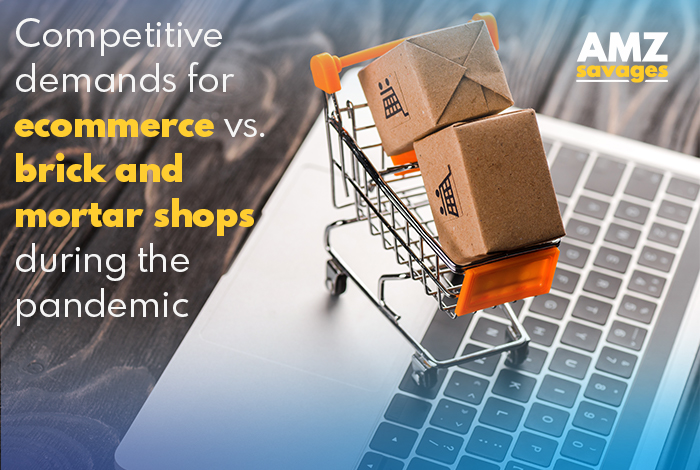What Technology Has Meant For People, Pre-Pandemic
✓ Technology has connected people from all over the world
✓ Technology has made information more accessible and readily available
✓ Technology has improved the lives of millions
✓ Technology has revolutionized the shopping experience
✓ Technology has allowed entrepreneurs the ability to sell products and services globally when they wouldn’t have been able to do this with a brick-and-mortar model
The Effect of Covid on U.S. Ecommerce During 2020…
✓ According to TechCrunch, the pandemic caused an accelerated shift for ecommerce by at least five years and improved the preference for online shops compared to physical shops.
✓ Ecommerce projections grew by 20% while department stores declined by almost half within that time span.
✓ In 2020, Amazon directly benefited with 40% sales growth and a record-breaking quarterly profit at the end of 2020.
The Effect of Covid on Global Ecommerce During 2020…
✓ According to the United Nations news report, ecommerce sales worldwide increased to 26.7 trillion USD during the pandemic, which is a 4% increase from the year prior.
✓ Ecommerce retail profit shares rose from 16% to 19% compared to its traditional equivalent.
✓ A total of 1.3 NEW AMAZON SELLERS WORLDWISE joined the famous platform.
The Effects of Covid on Brick and Mortar in 2020
Brick and Mortar stores, restaurants, and the service industry suffered the most during the onset of COVID. According to IBM, COVID-19 disrupted the retail industry in six major areas:
- Business Continuity – restricted access and movement in the non-essential retail establishments.
- Operational Guidelines for delivery and contactless pickup
- Pandemic-Driven Safety Measures – disinfecting, sanitizing, wearing gloves, forgoing menus for QR codes
- Finance Income Flow – Less customers, less sales, a cash shortage
- Privacy and Cybersecurity Threats – Scammers and fraudsters infect the digital space as people (some for the first time) became more dependent on digital devices.
- Workforce and Supply Shortages – employees working from home, high unemployment rate, not being able to return to a regular job
Most brick-and-mortar businesses are developing technologies to compete with e-commerce by improving the following:
✓ Supply chain (ex. Turning to other local businesses instead of international manufacturers)
✓ Consumer Experience (ex. Creating things like QR codes, mandating masks/vaccines, limiting how many people are in an establishment)
✓ Operations (ex. Imposing vaccine and mask mandates on employees, minimizing stuff that can be touched).
✓ Innovation and technology (ex. Booking online, offering curb-side pickup, adding more delivery drivers)
While traditional businesses are turning to technology for the answer, several things remain the same: People still enjoy the occasional window shopping and mall aisle strolling, so brick and mortar shops will still have their place in consumers’ hearts.
How Consumers Prefer Post-COVID-19 Pandemic Shopping
✓ Buyers have an enhanced sense of what goods are considered essential and non-essential.
✓ Brick and mortar store retailers should quickly adapt to include omnichannel fulfillment capacities to remain competitive.
✓ Massive retailers like Target and Walmart have adapted omnichannel fulfillment. (ex. Walmart’secommerce investments drove sales up around 97% in the final quarter of 2020, and Target’s same-day-fulfillment services grew at about 273% in the same timeframe.
✓ Companies like Shipt, Uber Eats, and DoorDash had created a safe and convenient channel for which consumers rely on
Projections moving into 2022…
According to market analysts, the pandemic will continue benefiting the eCommerce industry moving into 2022. Expected projections:
✓ 15% penetration rates to rise to 25% by 2025, advancing a 67% increase in half a
✓ Over one hundred thousand retailers may shut down in the next five years because of this shift.
What does all of this mean for the average small business owner trying to sell online?
The Good News:
✓ If you own a physical business, don’t be so quick to shut your doors. There are still certain things people prefer to purchase in real life: clothing, shoes, perfume, furniture, homemade goods, photography, and knives (among other things).
✓ Due to extended isolation periods, people are more likely to want to get out and give their business to brick-and-mortar entities
The Bad News:
✓ As new variants of COVID continue to rise, there is no real end-in-sight for COVID restrictions to be lifted, creating a social codependent relationship with online retail
What These Trends Mean For You
✓ 2022 is the perfect opportunity to seize online retail. You can create a well-established eCommerce shop with a professional business development specialist and cash in on the valuable, ecomm real-estate as customers continue to heavily on online retail for their daily needs.
✓ While there is always overhead (even with online selling), most interested sellers can start a business with as little as $10,000 without having to worry about expenses like real-estate rent, electricity, day-to-day operations, and employee insurance and payroll.
How The Legendary Tool by AMZ Savages Can Help With Your Entrepreneurial Journey:
✓ No more “me too” products
✓ Product research that factors all your expenses – from manufacturing to inspections to warehouse fees to Amazon fees to marketing.
✓ Unique products that are tailored for your budget, interest, and projected profit margins
✓ 24/7 help and guidance with all of your questions and concerns

